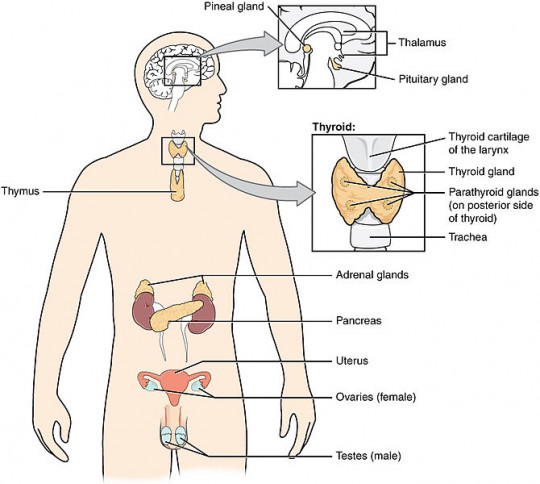3.4
The Endocrine System
The endocrine system is responsible for body processes that happen slowly. It consists of glands that secrete hormones. Hormones regulate a wide range of functions in the human body such as metabolism, mood, growth and development. The endocrine system also maintains homeostasis (the state of balance of chemicals) in our body as it regulates and coordinates all the other organ systems.
Glands are small organs located in the brain, neck, abdomen and pelvis. The major glands include the pituitary gland, the pineal body, the thyroid gland and parathyroids, the thymus, the adrenals, the pancreas and the reproductive glands (ovaries and testes).
Glands secrete more than 20 major hormones directly into the bloodstream.
Definition
Hormones are substances telling your cells what to do. They work as the body's chemical messengers. They travel throughout our circulatory system and transfer instructions to cells in other parts of the body.
Note
Although many different hormones circulate throughout the bloodstream, each hormone has its own receptor, so each hormone will communicate only with specific target cells that possess receptors for that hormone. Once the hormone binds to its target cell and delivers its message, the cell performs the action.
Hormone levels can be influenced by many factors, such as stress, infection, and changes in the balance of fluid and minerals in blood. When hormone levels reach a certain amount, further secretion is stopped by a very important body mechanism called a negative feedback.
Example
For example, the pancreas releases insulin to lower the level of blood sugar. If there is enough insulin and the level of sugar in the blood goes back to normal again, the insulin secretion stops.
In contrast, a positive feedback means a mechanism that increases hormone levels if the hormone level is low.
The primary link between the endocrine and nervous system is the hypothalamus. The hypothalamus nerve cells control the pituitary gland by producing chemicals that stimulate or supress its hormone secretions.
Hypophysis, also called the pituitary gland, sits beneath the hypothalamus. Although it is as big as a pea, it is the most important part of the endocrine system. It's often called the ´master gland´ because it makes hormones that control hormone secretion of other endocrine glands.
The pituitary gland is divided into two parts: the anterior lobe (adenohypophysis) and the posterior lobe (neurohypophysis). Each lobe produces different types of hormones.
The anterior lobe releases trophic hormones stimulating other endocrine glands and direct-acting hormones. The trophic hormones regulate the hormone production in the thyroid, adrenals and reproductive glands. The direct-acting hormones carry the message directly to their target tissue and perform the action.
Example
Trophic hormones are
- thyroid – stimulating hormone (TSH) encouraging the thyroid gland to produce thyroid hormones
- adrenocorticotropic hormone (ACTH) stimulating the adrenals to produce their hormes
- luteinizing hormone (LH) and follicle-stimulating hormone (FSH) making the gonads secrete their hormones
Example
Direct-acting hormones are
- growth hormone (GH) stimulating the bone growth, building new tissues and development in children
- prolactin activating milk production in breastfeeding women
The posterior lobe releases antidiuretic hormone (ADH), which controls body´s water balance through its effect on kidneys and also constricts small blood vessels when blood pressure falls; and oxytocin, which triggers the contractions of the uterus during labour.
The pituitary gland also secretes endorphins, which reduce our sensitivity to pain.
The pineal gland is located in the middle of the brain. It secretes melatonin, a hormone regulating the sleep-wake cycle.
The thyroid gland is located in the front part of the neck. It produces thyroxine and calcitonin. Thyroxine plays a key role in bone growth and the development of the brain and nervous system in children. It also regulates metabolism and body heat production. Calcitonin regulates the level of calcium and phosphorus in the blood by inhibiting its release from bones.
The parathyroid glands are four tiny glands attached to the thyroid gland. They release parathormone (PTH), which has an opposite function to that of calcitonin, so it increases the level of calcium in the blood.
The adrenal glands sit on top of the kidneys. There are two layers, each producing different hormones. The adrenal cortex produces aldosterone, which regulates mineral balance in the body and cortisol, which regulates metabolism in the body. The adrenal medulla produces fight-or-flight hormones preparing our body for stress, such as epinephrine (adrenaline) and norepinephrine (noradrenaline).
The pancreas is located behind the stomach. It is both an endocrine and exocrine gland. As for the exocrine function, it secretes juices that break down carbohydrates, proteins and fats. As an endocrine gland, it produces hormones in the islets of Langerhans. The beta cells produce insulin, while the alpha cells release glucagon. Insulin decreases the level of sugar in the blood. In contrast, glucagon increases it.
The gonads produce sex hormones. In males, the gonads are called testes. They are located in the scrotum and secrete testosterone. This hormone regulates body changes linked to sexual development, such as the enlargement of the penis, growth spurt during puberty, deepening of the voice, growth of facial and pubic hair and increase of the muscle bulk. Testosterone also supports the production of sperm.
The female gonads, the ovaries, are located in the pelvis. They produce eggs and secrete the female hormones estrogen and progesterone. Estrogen is involved in the development of female sexual features such as breast growth, the accumulation of body fat around the waist, growth of pubic hair, growth spurt during puberty and having the first period. Both estrogen and progesterone are involved in the regulation of the menstrual cycle and pregnancy.
+

Source: Author OpenStax College, 1801 The Endocrine System, license Creative Commons BY 3.0
Fig. 6. Endocrine glands
Note
Some endocrine conditions include diabetes mellitus, pituitary tumors, hyperthyroidism, hypothyroidism, gigantism, dwarfism and precocious puberty.